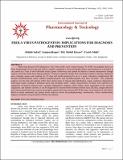| dc.identifier.citation | Sukul, Abhijit; Haque, Sanjana; Hasan, Md. Mehdi & Uddin, Farid (2016). Ebola virus pathogenesis: implications for diagnosis and prevention, International Journal of Pharmacology & Toxicology.6(2), 74-81. | en_US |
| dc.description.abstract | Ebola virus disease (EVD) declared as “one of the world‟s most virulent diseases” by WHO was popularly known as Ebola haemorrhagic fever in the past which is usually considered a severe and deadly illness when humans are concerned. It can caused by a virus of the Filoviridae family (genus Ebolavirus) and spreads by human to human transmission through contacts with body fluids from infected patients. Common symptoms include fever, profound weakness, diarrhea, abdominal pain, cramping, nausea and vomiting for 3-5 days and maybe persisting for up to a week. Laboratory complications like elevated aminotransferase levels, marked lymphocytopenia, and thrombocytopenia may have occurred. The symptoms progress over the time and patients suffer from various types of diseases like dehydration, stupor, confusion, hypotension, multi-organ failure, leading to fulminant shock and eventually death. Others characteristics of Ebola virus infections are suppression of immune response and a systemic inflammatory response, which further causes impairment of the vascular, coagulation, and immune systems. It can be diagnosed by enzyme -linked immuno-sorbent assay (ELISA), antigen detection tests, serum neutralization test, reverse transcription polymerase chain reaction (RT -PCR) assay, virus isolation by cell culture. Based on above mentioned, the present article aimed to review the pathophysiology, transmission, clinical manifestation, diagnosis, treatment, and prevention of Ebola virus disease | en_US |

